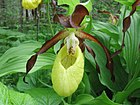Albtrauf Donzdorf - Heubach
|
FFH area
"Albtrauf Donzdorf - Heubach" |
||
| location | District of Göppingen and Ostalbkreis , Baden-Württemberg , Germany | |
| Identifier | DE-7224-342 | |
| WDPA ID | 555521850 | |
| Natura 2000 ID | DE7224342 | |
| FFH area | 25.333 km² | |
| Geographical location | 48 ° 44 ' N , 9 ° 52' E | |
|
|
||
| Setup date | January 1, 2005 | |
| administration | Regional Council Stuttgart | |
| particularities | Eight sub-areas | |
The area Albtrauf Donzdorf - Heubach is with regulation from 1 January 2005 by the Stuttgart Regional Council after the Directive 92/43 / EEC (Fauna and Habitats Directive) be trained reserve (reserve identifier DE-7224-342) of the East German State of Baden-Wuerttemberg .
location
The approximately 2,530 hectare (ha) large protected area " Albtrauf Donzdorf - Heubach" belongs to the natural areas of Albuch and Härtsfeld , Middle Alb foreland and Eastern Alb foreland . Its eight sub-areas are at an average altitude of 567 m above sea level. NHN and extend into two counties and seven municipalities:
-
District of Göppingen - 34%
- Donzdorf - 430.66 ha = 16%
- Went on the Fils - 25.33 ha = 1%
- Cake - 50.66 ha = 2%
- Lauterstein - 379.99 ha = 15%
-
Ostalbkreis - 66%
- Heubach - 582.65 ha = 23%
- Schwäbisch Gmünd - 531.99 ha = 21%
- Waldstetten - 557.32 = 22%
description
The protected area "Albtrauf Donzdorf - Heubach" is described as "in the Upper Jura mountain ranges on the northern edge of the Swabian Alb with extensive natural deciduous forests as well as juniper heaths and rock formations, 84 caves and large meadows".
Protection purpose
The main protective purpose is the preservation of a landscape with extensive beech forests, juniper heaths and limestone grasslands, limestone cliffs and limestone pioneer grasslands, lean flatland hay meadows, occurrence of the great mouse-eared bat and Bechstein's bat as well as a strongly fragmented area of the night eaves with rear erosion .
Habitats
The diversity of dry and humid habitat types in the protected area is described, among other things, by “flowing waters with flooding water vegetation”, “limestone grasslands”, “species-rich grasslands”, “ravine and hillside mixed forests” and “orchid-beech forests”.
Habitat classes
| Non-forest areas with wooden plants, scrub, etc. | 1 % | |||
| Deciduous forest | 54% | |||
| Mixed forest | 14% | |||
| Coniferous forest | 4% | |||
| Moist and mesophilic grassland | 16% | |||
| Reclaimed grassland | 9% | |||
| Heath, steppe, dry grass | 1 % | |||
| Different farmland | 1 % | |||
Flora and fauna
The following species, described in accordance with Article 4 of Directive 2009/147 / EC and Annex II of Directive 92/43 / EEC, are of relevant importance for assessing the area:
flora
-
Orchids (orchidaceae)
- Yellow lady's slipper ( Cypripedium calceolus ), " Orchid of the Year " in Germany in 1996 and 2010
fauna
-
Butterflies (Lepidoptera)
- Fritillary butterfly or ash Scheckenfalter '( Euphydryas maturna )
See also
Individual evidence
- ↑ Profile of the FFH area in the LUBW's list of protected areas
Web links
- Ordinance, data evaluation sheet and map in the profile of the FFH area in the LUBW protected area directory



